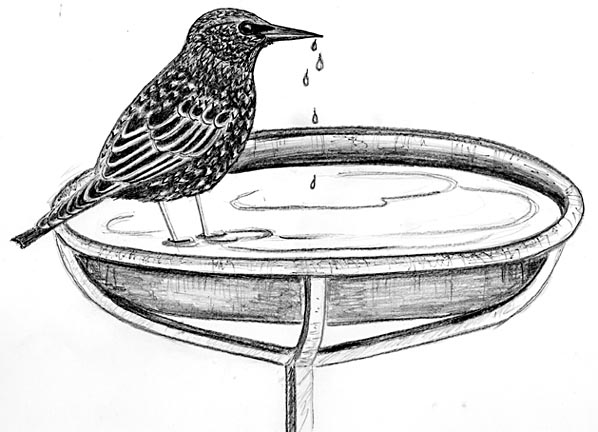
Dear Bird Folks,
Please find the attached photo of a bird in my birdbath. I think it might be an immature flicker. However, I’m not sure because I can’t find a picture of young flicker in any of my books. Am I right?
– Gwen, N. Eastham, MA
It’s a turkey, Gwen,
The bird in your birdbath is a Wild Turkey. How cool is that? Okay, fine. It’s not a turkey, not even close. I just said that because it’s the week of Thanksgiving, which means it’s the time of year when anyone who writes about birds is required by law to write a story about turkeys. If we don’t at least mention something about them, we are subject to a $5.00 fine, or two years in jail, or both. Two years in jail doesn’t seem so bad since I could use the break. But there is no way I can afford five bucks right now, so that’s why I had to slip the T-bird into your answer. I hope you don’t mind. It’s all about fulfilling my required turkey talk.
The bird in your photo is not a flicker, young or old. It’s a (be prepared for disappointment) European Starling. Yup, it’s a trashy, old starling. I can see why you thought it was a young flicker, though. Starlings have rather long flicker-like bills and in the winter they are brownish with flicker-ish speckles. They look just like young flickers should look. But the trouble is even young flickers don’t look like young flickers. Flickers look like their parents from the moment they leave the nest. That’s the reason why you couldn’t find a picture of one in your book. It’s like trying to find a clean restroom at a gas station. It doesn’t exist.
Flickers may look the same all of their lives, but starlings have enough plumage changes for both birds. Young starlings are a nondescript gray/brown, with no speckles or any other exciting field marks. But as the birds become older their colors become more interesting. By fall all starlings have molted into a brownish plumage that is covered in white spots. This may not sound like a very noteworthy plumage at first, but as the fall turns into winter and winter turns into spring, the bird’s appearance continuously changes. The rigors of the season causes wear on the bird’s feathers, resulting in the slow wearing away of the white spots. By spring most of the spots are gone and the birds have become purplish/black. The starlings of spring look like totally different birds than they did in the fall, yet they haven’t added any new feathers. The transformation is the result of feather wear. There is one other change that happens to starlings in the spring: their bills change from black to bright yellow. I have no idea how they manage that trick, but it’s very impressive.
In case you don’t know it already, as their name implies, European Starlings are an import from overseas. In 1890 some bonehead brought 100 of these birds to New York City and over the course of the next century their North American population exploded, going from 100 birds to over 200 million. With a population that size I’m surprised your photo only had one bird in it, Gwen. Starlings are extremely gregarious birds and are often seen in huge flocks. Seeing a flock numbering in the hundreds is not uncommon here on Cape Cod, but in some locations wintering flocks of starlings can number in the hundreds of thousands. Anyone who has access to a computer should punch up YouTube and do a search for “starlings in Otmoor.” There you’ll see a video of a ridiculous number of starlings returning to their evening roost. The compact flock, which seems to contain millions of birds, erratically wheels back and forth across the sky looking like a breakdancing plume of smoke. It is quite the sight so if you’ve never seen break dancing smoke, this is your chance.
As you might have guessed 200 million introduced birds doesn’t happen without problems. Noted avian writer Pete Dunne calls European Starlings “real Americans” because they started in the cities, moved to the suburbs and proceeded to “kick out the natives” as they spread across the continent. The natives in this case are bluebirds, martins, swallows or any bird that wants to build its nest in a cavity. Starlings may have cool, ever-changing plumage and the skill to fly in a tight, massive flock without smacking into each other, but they don’t have the ability to dig out their own nest cavities. Instead, they must usurp our native birds, which they can easily do. Even woodpeckers aren’t able to stave off these aggressive birds. The starlings simply wait for the woodpecker to do all the work and then they take over, which forces the woodpecker to move in with its in-laws, and that’s never a good thing.
Don’t feel bad that you thought the starling in your photo was a young flicker, Gwen; nature can be tricky. I remember looking out of my second grade classroom window and seeing a bear. I shouted, “Mrs. Roberts, there’s a bear outside!” It turned out the bear was the neighbor lady walking across her yard in a brown bathrobe. Events like this were part of the reason why the school psychologist had my parents’ phone number on speed dial.